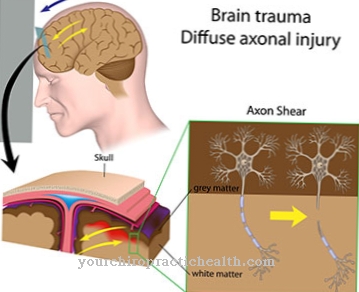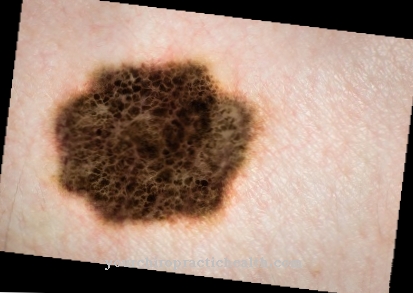The Millard-Gubler Syndrome is a brain stem syndrome after damage to the caudal pons. The most common cause of this phenomenon is a stroke. Characteristic of brainstem syndromes are the crossed symptoms of paralysis, which are primarily countered with physiotherapy.
What is Millard-Gubler Syndrome?

© magicmine - stock.adobe.com
The human brain stem is composed of the parts of the brain below the diencephalon. With the exception of the cerebellum, these are the midbrain and the hindbrain including the associated structures of the cerebrum, midbrain hood, midbrain roof, bridge and elongated spinal cord.
Damage to the structures involved in the brain stem is associated with functional impairment of the motor system and is also known as brain stem syndromes. Depending on the exact location of the damage, a distinction is made between different brainstem syndromes, the common feature of which is crossed paralysis symptoms. One of the midbrain syndromes is that Millard-Gubler Syndrome.
This disease is named after its first description, the French doctors Millard and Gubler. The first description is dated from the 19th century. Due to the location of the damage and the symptoms, Millard-Gubler syndrome is also known in the specialist literature as caudal bridge foot syndrome or Abduzens-Facialis Syndrome known. Sometimes it is also dated Raymond Foville Syndrome the speech.
causes
Like all brain stem syndromes, Millard-Gubler syndrome is due to damage to the brain stem region. This damage usually takes place in the course of a stroke. In Millard-Gubler syndrome, the primary cause is usually a stroke within the vertebral artery basin.
In the caudal sections of the bridge (pons), the nucleus nervi facialis, the core area of the facial nerves, is damaged in this event. The abducens nerve emerges in the immediate vicinity of this region and is also affected by the ischemic stroke processes. In addition, the pyramidal tracks are affected by the damage.
Although the stroke is the most common cause of Millard-Gubler syndrome, other disease events can also be considered as primary causes. Tumors in the caudal bridge region are just as conceivable as bacterial or autoimmunological inflammations. Mechanical damage after accidents is responsible for the clinical picture much less often.
Symptoms, ailments & signs
Like all brainstem syndromes, Millard-Gubler syndrome is characterized by crossed paralysis symptoms. In this context, crossing means the inclusion of both sides of the body. In principle, the left side of the brain controls the right half of the body and vice versa. However, this only applies from the pyramidal orbit crossing near the spinal cord.
For example, the facial nerves emerge on the same side of the body as they are connected to the brain. With crossed symptoms of paralysis, both the facial nerves on the side of the brain damage and the nerves from the spinal cord on the opposite side of the brain damage are impaired. In Millard-Gubler syndrome, facial palsy and abdomen palsy occur on the damaged side for this reason.
On the opposite side, the involvement of the pyramidal tract leads to spastic hemiplegia. In this context, spastic means that the muscles on the paralyzed side show increased tone and, for this reason, the limbs can only be moved to a limited extent or not at all.
Diagnosis & course of disease
The diagnosis of Millard-Gubler syndrome is made by the doctor on the basis of the clinical symptoms. To confirm the suspected diagnosis, he orders an imaging procedure such as an MRI of the head. In the caudal bridge region of the brain stem, the primarily causal brain damage is shown in the slice images. The MRI can also be used for fine diagnostics.
Tumors, for example, show a particularly characteristic picture in the slice image, which is clearly different from inflammatory and ischemia-related brain damage. In case of doubt, no CSF analysis can also take place. A sample of the brain water is taken from the external liquor space and given to the laboratory.
Bacterial, autoimmune and tumor-related disease processes within the brain often change the composition of the cerebral water in a specific way. The prognosis for patients with Millard-Gubler syndrome depends on the extent of the damage and the treatability of the primary cause of damage.
Complications
Millard-Gubler syndrome leads to paralysis on the patient's body, which can occur in various places. Especially in the face, the paralysis and the disturbances of the sensitivity can be very unpleasant and lead to significant restrictions in the life of the patient. Not infrequently, those affected are then dependent on the help of other people in their everyday life and can no longer carry out certain activities on their own.
The intake of food and fluids can also be restricted, so that Millard-Gubler syndrome greatly reduces the patient's quality of life. Movement restrictions also occur and those affected suffer from muscle weakness and fatigue. The treatment of Millard-Gubler syndrome usually takes place causally and depends primarily on the underlying disease that is responsible for these symptoms.
If this is a tumor, it may have spread to other areas of the body. Furthermore, those affected are mostly dependent on physiotherapy. As a rule, it cannot be generally predicted whether there will be a reduction in life expectancy.
When should you go to the doctor?
Since Millard-Gubler syndrome is a congenital disease and it cannot heal itself, a doctor must be consulted in any case with this complaint. Without treatment, the symptoms of Millard-Gubler syndrome can make life much more difficult for those affected. A doctor should usually be consulted if the patient suffers from symptoms of paralysis that can occur in different parts of the body. Often one side of the patient's body is paralyzed, so that this side cannot move.
Millard-Gubler syndrome can also lead to spastic disorders, so that the limbs can only be moved to a very limited extent. If these symptoms occur, a doctor should always be consulted. An MRI scan of the head is usually necessary to diagnose and establish Millard-Gubler syndrome, so that this disease cannot be diagnosed by a general practitioner. The patient's life expectancy is usually not negatively affected by the disease, but it can only be treated to a limited extent.
Treatment & Therapy
Therapy for patients with Millard-Gubler syndrome depends on the primary cause. In the case of acute inflammation, conservative drug treatment is used. Autoimmunological inflammation is countered with cortisone.
In addition, patients with autoimmune diseases such as multiple sclerosis receive long-term therapy with immunosuppressants, which are intended to weaken the immune system and thus reduce future inflammation. In the context of Millard-Gubler syndrome, bacterial inflammation is in turn made to heal using antibiotics as soon as the type of causative agent has been determined.
If tumors have caused the symptoms, an operation for excision is carried out as far as possible. Depending on the degree of malignancy, drug therapy or radiation therapy may be required. Inoperable tumors are also treated with these measures. If a stroke has caused the syndrome, stroke prevention takes place immediately to reduce the risk of future ischemia.
Regardless of the cause, symptomatic treatment takes place in addition to the mentioned therapeutic steps in Millard-Gubler syndrome. Since the brain is home to highly specialized tissue, the regenerative capacity in the brain tissue is severely limited. This means that damage to the brain tissue is irreparable.
However, especially in stroke patients, the redistribution of brain functions from defective areas to healthy areas in the neighborhood could be observed. To support this redistribution, patients with Millard-Gubler syndrome receive physiotherapy and, if necessary, speech therapy, as well as accessing the functions of the damaged areas together with specialists. The brain can thus be moved to redistribute.
Outlook & forecast
As a result of the disease, those affected suffer from various mental and physical complaints. The quality of life is therefore significantly restricted. Those affected are permanently dependent on the help and support of relatives. Simple activities can no longer be carried out independently. Because of this, major depression and other mental illnesses are common.
The movement and coordination of those affected is also impaired. Speech disorders, paralysis and disorders of sensitivity can occur. Those affected often suffer from dizziness. Paralysis of the tongue can also occur. Those affected can then no longer ingest food or liquids independently. Artificial nutrition may be necessary to prevent the body from becoming undersupplied. Due to the illness and suffering of the person concerned, relatives can also suffer from severe depression and other mental illnesses.
It cannot be said whether the disease will progress positively after treatment. It can therefore be possible that those affected have to spend their entire life with the symptoms and deal with them. The life expectancy of those affected is usually only reduced if the tumor cannot be removed. In other cases, the disease has no effect on people's life expectancy.
prevention
In the context of Millard-Gubler syndrome, preventive measures are limited to stroke prevention. In addition to concentrating on a healthy diet and sufficient exercise, risk factors such as tobacco consumption are minimized as far as possible in the context of stroke prevention.
Aftercare
Millard-Gubler syndrome can lead to serious complications or discomfort for those affected and must therefore be treated by a doctor in any case.There is also no independent healing, so that the patient is always dependent on treatment by a doctor. In most cases this syndrome leads to severe paralysis of the person concerned.
The paralysis can affect different parts of the body and have a very negative effect on the quality of life of the person affected. This results in significant restrictions in the everyday life of the person affected, so that most patients are dependent on the help and support of friends or their own family. It is not uncommon for Millard-Gubler Syndrome to lead to severe depression or other psychological disorders in relatives.
There is severe paralysis in the muscles, so that the patient can no longer move independently. The paralysis often only occurs on one side of the body. In some cases, the disease can also lead to mental complaints, so that those affected by Millard-Gubler syndrome sometimes suffer from reduced intelligence.
You can do that yourself
Which measures those affected can take themselves depends on the cause and severity of the disease. Acute inflammation is usually treated with medication, supported by bed rest and rest. Medicines are also the best choice for autoimmune inflammation.
The most important self-help measure is to document the effects of the medication and thus to achieve an optimal setting of the respective remedy. In the event of serious complications, the doctor should be informed. If Millard-Gubler syndrome occurs as a result of a tumor, surgery is necessary. Sufferers can best support the procedure by following the diet suggested by the doctor before the operation. A balanced diet supports the immune system and contributes to the healing process. After an operation, rest also applies. Radiation therapy is also best survived by avoiding stress on the body as much as possible.
In addition to these measures, symptomatic treatment is required. Neurological damage can be corrected through physiotherapy and, if necessary, speech therapy. Therapeutic advice is particularly useful if Millard-Gubler syndrome has caused severe brain damage that has a lasting effect on the patient's quality of life and well-being.


.jpg)
























